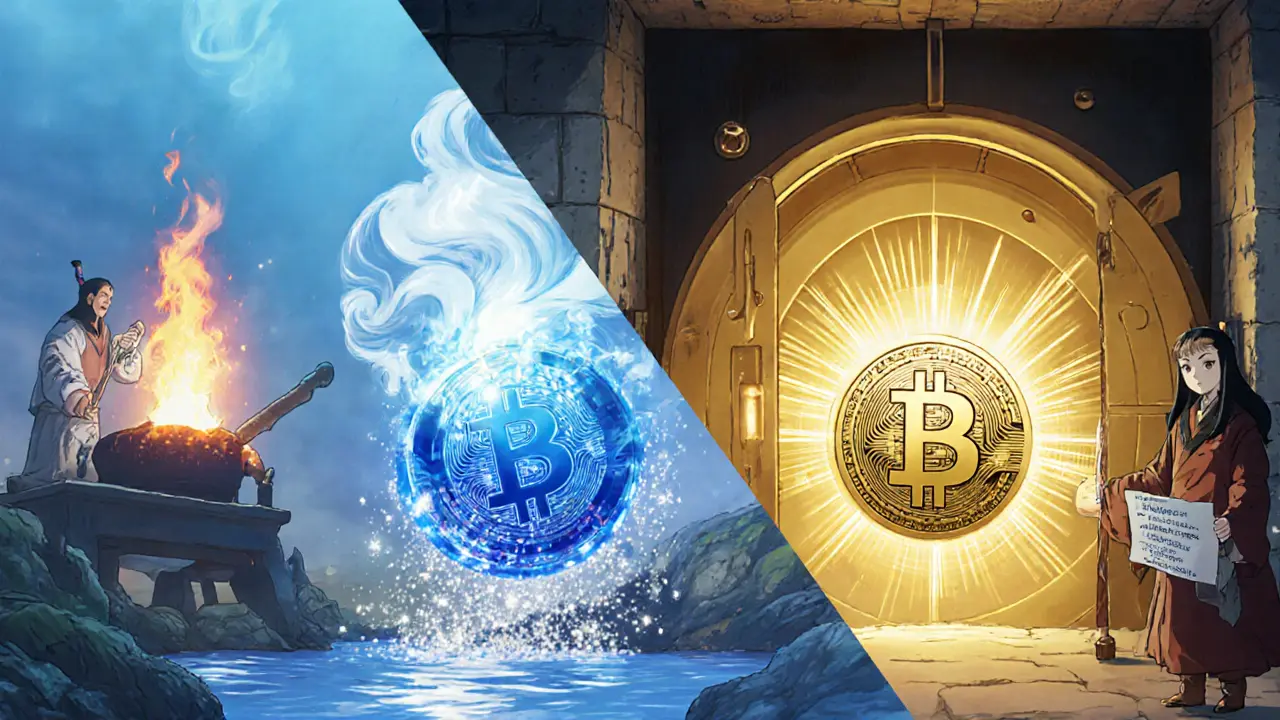Cross-Chain Bridge Cost & Time Estimator
In the crypto world, Cross-Chain Bridge is a protocol that connects separate blockchain networks, allowing assets, data, or commands to move between them. Imagine trying to send a text from an iPhone to an Android phone without any service-cross-chain bridges are the universal messenger that makes that possible for blockchains.
Quick Takeaways
- Cross-chain bridges let you move tokens, NFTs, and data between isolated blockchains.
- They work by locking the original asset on the source chain and minting a wrapped version on the destination chain.
- Bridges come in two flavors: trusted (centralized) and trustless (decentralized).
- Popular examples include Wormhole, Polkadot, Cosmos, and atomic swaps.
- Security remains the biggest risk-always pick audited, reputable bridges.
What Exactly Is a Cross-Chain Bridge?
A cross-chain bridge is a piece of software that links two otherwise incompatible blockchains. Each blockchain follows its own consensus rules-Bitcoin uses proof‑of‑work, Ethereum runs proof‑of‑stake, Solana relies on a unique Proof‑of‑History model. Because these rules don’t speak the same language, assets are stuck on their native chains. A bridge translates the “ownership” signal from one chain into a corresponding signal on another, preserving the 1:1 value relationship.
How Do Bridges Move Assets? The Lock‑Mint‑Burn Cycle
Most bridges rely on a lock‑mint‑burn workflow powered by smart contracts. Here’s the step‑by‑step flow:
- Lock: You send your original token (e.g., Bitcoin) to a special contract on the source chain. The contract holds the asset and records the amount.
- Mint: The bridge’s counterpart on the destination chain creates a wrapped version (e.g., Wrapped Bitcoin (WBTC)) that represents the locked Bitcoin on the new chain. The wrapped token is pegged 1:1, meaning one WBTC equals one BTC.
- Use: You now interact with the wrapped token just like any native asset-trade it on a DeFi protocol, stake it, or send it to a friend.
- Burn & Unlock: When you want your original BTC back, you burn the WBTC on the destination chain. The bridge then releases the locked BTC on the source chain, completing the round trip.
This cycle prevents double‑spending because the total supply across both chains never exceeds the original amount.
Trusted vs. Trustless Bridges
Not all bridges are built the same. Broadly, they fall into two camps:
| Aspect | Trusted (Centralized) | Trustless (Decentralized) |
|---|---|---|
| Control | Operated by a single entity or a small consortium. | Governed by code and a network of validators. |
| Speed | Usually fast, since decisions are off‑chain. | Can be slower due to on‑chain consensus. |
| Security Model | Relies on the operator’s honesty and security practices. | Security comes from cryptographic proofs and economic incentives. |
| Failure Risk | Single point of failure; hacks or shutdowns affect all users. | Distributed risk; attacks require compromising a majority of validators. |
| Examples | Binance Bridge, Coinbase Custody Bridge. | Wormhole, Polkadot’s Relay Chain, Cosmos IBC, Atomic Swaps. |

Notable Bridge Projects and How They Differ
Below are a few of the most widely used bridges, each solving interoperability in its own way:
- Wormhole: Connects Ethereum, Solana, Binance Smart Chain, and other networks. It’s a trustless bridge that uses a set of guardians to validate cross‑chain messages.
- Polkadot: Provides a whole ecosystem of parachains that communicate via the Relay Chain. Polkadot’s architecture is built for seamless token transfers and shared security.
- Cosmos: Employs the Inter‑Blockchain Communication (IBC) protocol, enabling any IBC‑enabled chain to send packets of data and tokens to another. Think of it as the “internet of blockchains”.
- Atomic Swaps: Allow two parties to exchange assets directly across chains without a third‑party bridge. The swap is executed by a hashed timelock contract (HTLC) that ensures both sides fulfill the trade or the transaction reverts.
- Wrapped Bitcoin (WBTC): Not a bridge per se, but a concrete example of a wrapped asset created on Ethereum to represent Bitcoin. WBTC makes BTC usable in Ethereum DeFi apps.
Why Interoperability Matters: Real‑World Benefits
Cross‑chain bridges do more than just move tokens; they unlock new possibilities:
- Liquidity Boost: By moving USDC from Ethereum to a low‑fee chain like Arbitrum, you can earn higher yields on DeFi platforms without waiting for a centralized exchange.
- Access to Unique Features: Some chains excel at low‑cost NFTs, while others specialize in high‑throughput smart contracts. Bridges let you pick the best tool for each job.
- Reduced Custody Risk: Instead of sending assets to a centralized exchange for swapping, you can stay in a non‑custodial environment and let the bridge handle the conversion.
- Portfolio Diversification: Move your holdings across ecosystems to spread risk, especially useful during network congestion or high gas fees.
Security Concerns and Best Practices
Bridges have been high‑profile targets. The infamous 2022 Wormhole hack resulted in a loss of over $300million, underscoring the need for vigilance. Here’s how to stay safe:
- Choose Audited Bridges: Look for third‑party audit reports from firms like CertiK or Quantstamp.
- Prefer Trustless Options when possible-code‑driven security reduces reliance on a single entity.
- Start Small: Test the bridge with a minimal amount before moving large balances.
- Monitor Bridge Status: Many bridges publish real‑time health dashboards; avoid those showing “paused” or “under maintenance”.
- Use Multi‑Sig Custody for the source‑chain assets, especially if you’re bridging institutional funds.
Quick Checklist: Selecting the Right Bridge for Your Needs
- Is the bridge trustless or trusted?
- Does it support the source and destination chains you need?
- What are the fees (gas + bridge fee) compared to a centralized exchange?
- Has the bridge undergone recent security audits?
- Is there a community or developer support channel for troubleshooting?
Future Outlook: What’s Next for Cross‑Chain Technology?
As the blockchain ecosystem matures, interoperability is becoming a core layer rather than an add‑on. Projects like LayerZero aim to provide a universal messaging layer that any chain can plug into, potentially rendering separate bridges obsolete. Meanwhile, standards bodies are drafting formal inter‑chain communication protocols that could bring uniformity, reduce developer friction, and enhance security. In short, expect bridges to become faster, cheaper, and more resilient as the market pushes for a truly connected Web3.

Frequently Asked Questions
What is the difference between a wrapped token and a native token?
A wrapped token is a representation of another blockchain’s asset that lives on a different chain. For example, WBTC on Ethereum is backed 1:1 by Bitcoin locked on the Bitcoin network. The native token (BTC) only exists on its own blockchain, while the wrapped version can interact with contracts on the host chain.
Are trustless bridges completely risk‑free?
No. Trustless bridges eliminate a single point of failure, but they still rely on smart‑contract code and validator economics. Bugs, mis‑aligned incentives, or novel attack vectors can still cause losses.
How long does a typical cross‑chain transfer take?
Transfer times vary by the source and destination chains. Moving from Ethereum to Binance Smart Chain can take a few minutes, while transfers involving slower networks like Bitcoin may require 30‑60 minutes due to block confirmation times.
Can I bridge NFTs the same way I bridge ERC‑20 tokens?
Yes, many bridges now support NFT standards (ERC‑721, ERC‑1155). The NFT is locked on the original chain and a wrapped version is minted on the target chain, preserving its metadata and ownership.
What fees should I expect when using a bridge?
Fees typically include the source‑chain gas cost, a bridge service fee (often 0.1‑0.5%), and the destination‑chain gas cost. Some bridges subsidize part of the fee during promotions.








april harper
March 13, 2025 AT 14:30Bridges feel like the cosmic elevators of crypto, lifting assets into new realms.
VICKIE MALBRUE
March 16, 2025 AT 18:06Great breakdown! The estimator makes it easy to see trade‑offs.
Kate Nicholls
March 19, 2025 AT 21:42While the UI is clean, many users overlook that trustless bridges still rely on a set of validators, so the security model isn’t as hands‑off as the buzz suggests. It’s crucial to audit the underlying smart contracts before committing large sums.
Amie Wilensky
March 23, 2025 AT 01:18Notice-when you select a “Trusted (Centralized)” bridge, the transaction fee can skyrocket!!! Moreover, the latency often spikes due to manual confirmations; therefore, users should weigh the speed versus custody risk.
Naomi Snelling
March 26, 2025 AT 04:54People don’t tell you that hidden nodes in some “decentralized” bridges are actually run by the same entities that manage the main chain’s validators, so you’re not really escaping any central control.
Clint Barnett
March 29, 2025 AT 08:30Alright folks, let’s dive deep into why cross‑chain bridges are both a marvel and a minefield. First, the fundamental idea is to lock assets on the source chain and mint representative tokens on the destination chain, a process that mirrors the classic escrow model. This locking mechanism is typically handled by a smart contract or a set of validators, depending on the bridge architecture. In trustless designs, a quorum of independent validators observe the lock event and collectively approve the mint, which adds a layer of decentralization but also introduces coordination overhead. On the other hand, trusted bridges rely on a single entity or consortium, which can dramatically speed up confirmations but re‑introduces a single point of failure. The fee structure varies: some platforms charge a flat gas fee for the lock, plus a small percentage for the mint, while others bundle everything into a single dynamic fee that reacts to network congestion. Users should also be aware of the time lag; a typical trustless bridge might take anywhere from a few minutes to several hours, whereas a centralized bridge can often complete within seconds, albeit at the cost of custodial risk. Security audits are paramount-look for bridges that have undergone multiple third‑party reviews and have a proven track record of handling large volumes without incidents. The community’s sentiment, reflected in bug bounty payouts and open‑source contributions, can serve as an informal gauge of reliability. Additionally, consider the bridge’s governance model; if token holders can vote on upgrades, you have a say in the future safety of the system. Don’t forget to factor in the bridge’s liquidity pool depth-insufficient liquidity can lead to slippage or failed transfers. Finally, always test with a small amount first; this practice has saved many newcomers from costly mistakes. In summary, bridges are powerful tools that unlock interoperability, but they demand diligent research, prudent amount sizing, and an awareness of the trade‑offs between speed, cost, and security.
Jacob Anderson
April 1, 2025 AT 13:06Sure, because what could possibly go wrong when you trust a bridge that was written in a weekend hackathon?
Carl Robertson
April 4, 2025 AT 16:42The moment you think you’ve mastered cross‑chain transfers, the bridge crashes and you’re left staring at a void of lost tokens-pure theatrical tragedy!
Kate Roberge
April 7, 2025 AT 20:18I’m gonna say the hype around bridges is overblown; most users just end up paying extra fees for the thrill of moving a token that could have stayed put.
MD Razu
April 10, 2025 AT 23:54In the grand tapestry of decentralization, bridges are the threads that both bind and tear the fabric, prompting us to question the very notion of sovereignty in digital assets.
Charles Banks Jr.
April 14, 2025 AT 03:30Oh yeah, just click a button, wait 5‑10 seconds, and voilà-your coins are magically on another chain, no risk at all.
Ben Dwyer
April 17, 2025 AT 07:06Remember, start with a tiny amount to get the feel of the process; it’s the best way to build confidence without risking your portfolio.
Lindsay Miller
April 20, 2025 AT 10:42I understand it can be confusing; think of the bridge like an airport transfer-you check in, wait, and then collect your luggage at the other side.
Billy Krzemien
April 23, 2025 AT 14:18For those seeking reliability, look at bridges that have been live for over a year with minimal incidents; longevity often signals robustness.
Oreoluwa Towoju
April 26, 2025 AT 17:54Does anyone know which bridge offers the lowest fee for moving USDC from Ethereum to Solana?
Jason Brittin
April 29, 2025 AT 21:30Been using the Polygon↔️Ethereum bridge; it’s quick and cheap most of the time 😎.
Katrinka Scribner
May 3, 2025 AT 01:06OMG the fees are insane sometimes, like why even bother??
Waynne Kilian
May 6, 2025 AT 04:42Let’s appreciate that bridges are still evolving; the community’s feedback is driving innovations that will eventually lower costs and increase security.
Michael Wilkinson
May 9, 2025 AT 08:18Stop whining about fees and actually read the documentation; you’ll find the answers if you take the time.
Rajini N
May 12, 2025 AT 11:54Excellent summary! To add, many newer bridges are implementing zk‑rollups for proof‑of‑liquidity, which can cut both cost and finality time dramatically.